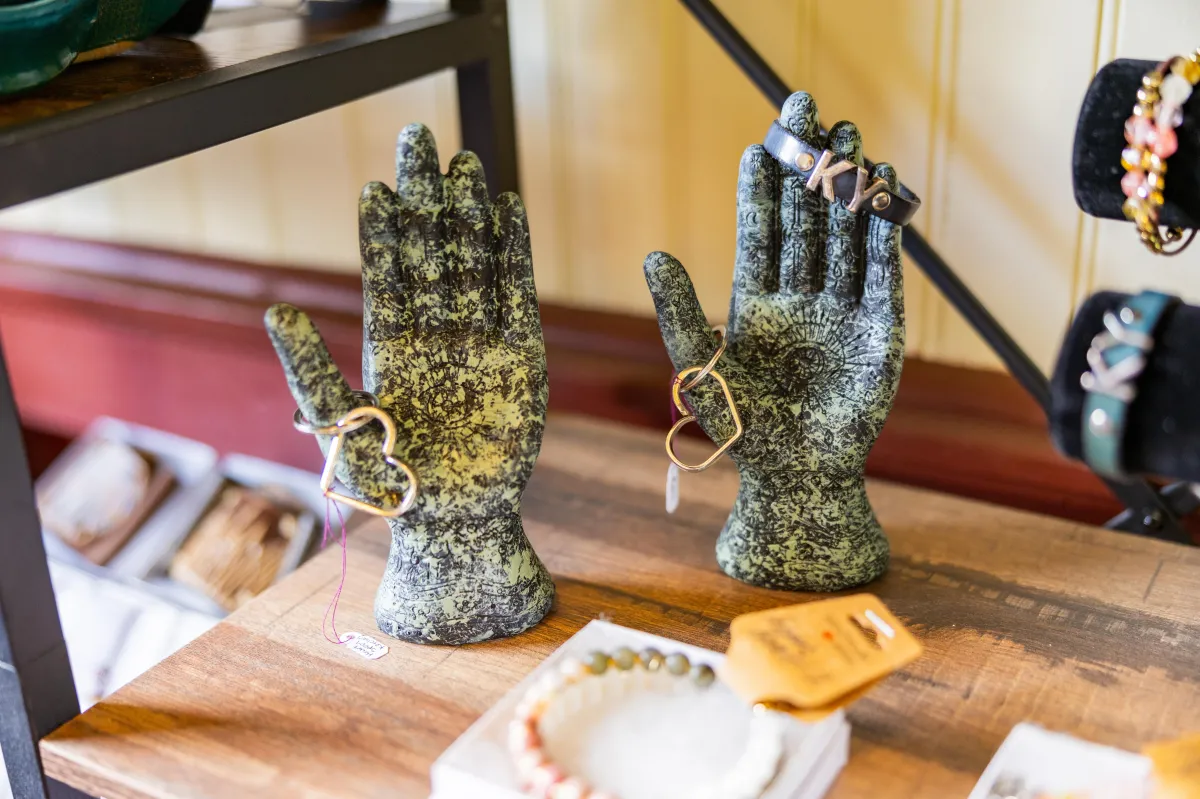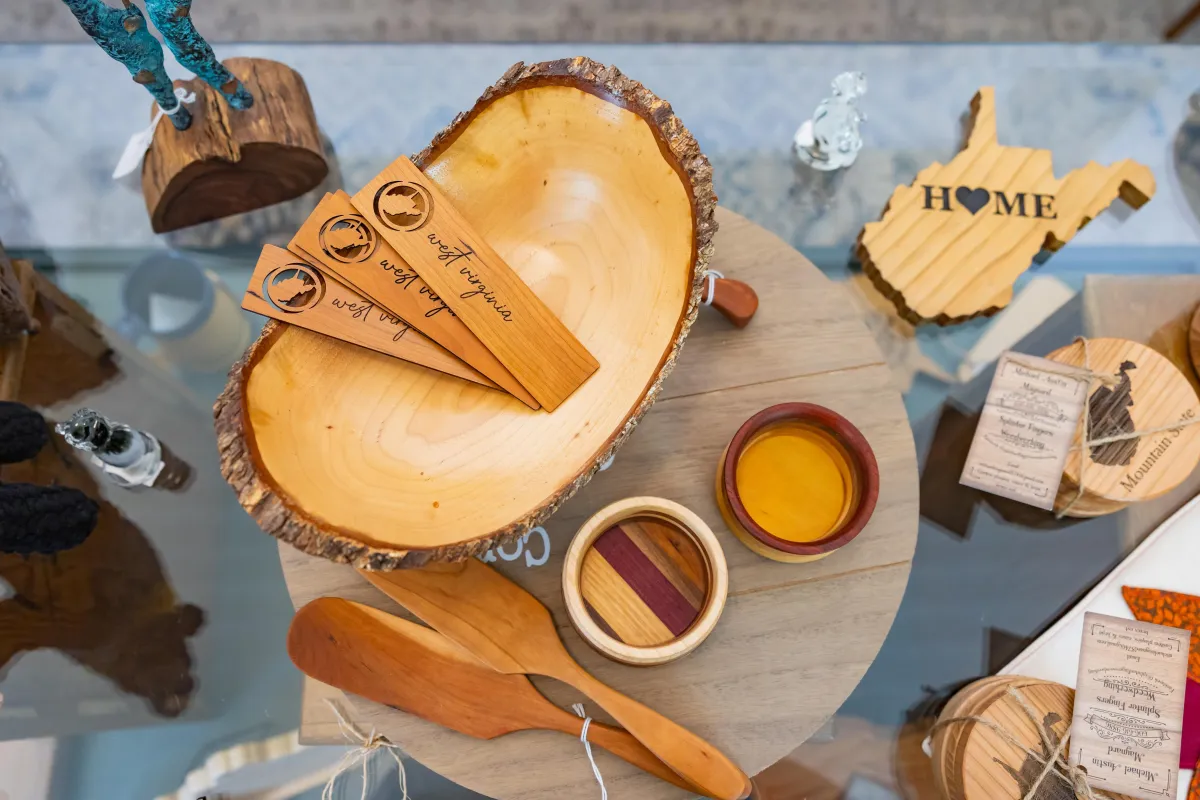All Genuine Mountain Made in West Virginia and Kentucky | 304-784-6778
Stories from the Mountain
Craft, culture, and community
At Old Mountain Field Fine Arts & Crafts, every handmade piece comes with a story. Our blog is where we share those stories — from the history of Appalachian quilting and pottery to spotlights on local artisans keeping traditions alive. Whether you’re curious about the heritage of mountain crafts or want to meet the makers behind our collections, this is the place to explore the culture and creativity of Appalachia.


What Makes Appalachian Woodworking Unique Among Artisans?
What Makes Appalachian Woodworking Unique Among Artisans?

Appalachian woodworking stands out for its deep-rooted heritage, hand-hewn craftsmanship, and community-centered tradition. From the early settlers who shaped forest resources into lasting furniture to modern artisans showcasing their skills at Old Mountain Field, this craft blends history, technique, and cultural pride. In this guide, you’ll explore the history of Appalachian woodcraft, traditional techniques, signature materials, distinctive artisan styles, cultural significance, and hands-on experiences at Old Mountain Field—all while connecting with local artisans in Appalachian crafts and discovering how community programming enriches this living heritage.
What Is the History of Appalachian Woodcraft?
Appalachian woodcraft emerged from necessity and resourcefulness, turning abundant hardwood forests into practical and decorative objects that supported pioneer life. This evolution created a unique regional craft that balances functional joinery with decorative carving, contributing to both daily life and cultural identity. Understanding this history lays the groundwork for exploring traditional methods and modern interpretations.
Crafting Appalachia: Examining Berea College's History and Traditions
Research highlights the Appalachian Craft Movement at Berea College, detailing the evolution of woodworking, the influence of styles like Colonial Revival, and the historical integration of diverse communities in craft production. It underscores how craft programs contributed to the college's mission and reflected complex relationships of race, class, and American identity.
This research provides historical context for the development of Appalachian woodcraft and its cultural significance, aligning with the article's discussion of history and heritage.
How Did Appalachian Woodworking Develop Over Time?
Appalachian woodworking began with Indigenous tool use and evolved through European settler techniques, merging to create durable, multifunctional designs. As settlers arrived, they applied joinery methods from England, Germany, and Scotland to local oak, maple, and hickory, forging furniture and implements that endure today. Over generations, these practices passed from family to family, linking communities through shared skills and passing the craft toward contemporary preservation efforts.
Which Historical Periods Influenced Appalachian Woodcraft?
Pre-Colonial Era – Indigenous communities shaped wood with stone-and-bone tools, establishing hand-hewing traditions.
18th–19th Centuries – European settlers introduced mortise-and-tenon joinery and chest construction, fostering durable storage pieces.
20th Century Revival – Folk art movements spotlighted decorative carvings and spindle work, preserving traditional aesthetics amid industrial change.
These periods collectively shaped the balance of utility and ornamentation that defines Appalachian creations, leading into a craft culture still celebrated in community gatherings and regional showcases.
What Role Did Appalachian Cultural Heritage Play?
Cultural heritage anchored Appalachian woodworking as a storytelling medium, weaving regional identity into each carve and joint.

Appalachian Art: Functional Crafting
This article explores the historical and cultural significance of Appalachian crafts, including woodworking, emphasizing their functional origins and evolution into artistic expressions. It highlights Native American influences and the intergenerational transmission of skills, noting how crafts like wood carving were essential for daily life and community bonding.
This source supports the article's points on the cultural heritage, functional nature, and community role of Appalachian woodworking, as well as its historical development.
What Are the Traditional Appalachian Craft Techniques?
Traditional Appalachian techniques emphasize hand tools, precise joinery, and surface carving to enhance both strength and beauty. Mastery of these skills ensures pieces withstand daily use while reflecting regional aesthetics. Examining core methods reveals why local artisans remain celebrated for their craftsmanship.
Which Woodworking Techniques Define Appalachian Artisanship?
Frame-and-Panel Joinery – Crafts sturdy doors, cupboards, and chest lids that resist warping.
Drawknife Shaping – Refines contours on chair legs and spindles by shaving thin wood layers.
Chisel Carving – Adds decorative folk motifs like scrolls and geometric patterns to functional objects.
How Are Tools Like Drawknives Used in Appalachian Woodworking?

A drawknife operates by pulling its blade toward the artisan, removing controlled wood shavings to form smooth curves and tapered profiles. This tool’s versatility allows shaping chair arms, table legs, and spoon bowls with responsive feedback on wood grain. Mastering drawknife work fosters an intuitive connection between artisan and material, a skill that underpins the craft’s distinctive organic forms.
What Are the Steps in Classic Appalachian Wood Carving?
Design Transfer – Trace pattern onto seasoned wood, ensuring grain alignment.
Relief Roughing – Remove background wood with gouge chisels to set depth.
Detail Carving – Refine edges and add texture using V-tools and veiners.
Sanding & Finishing – Smooth surfaces by hand, then apply local beeswax or tung oil.
These steps yield panels that blend motif clarity with durable surfaces, supporting both aesthetic and functional demands in Appalachian heirlooms.
What Materials Are Unique to Appalachian Woodworking?
Material selection in Appalachian craft incorporates local hardwood species prized for strength, workability, and beauty. Sustainable harvesting and knowledge of wood characteristics guide artisan choices, resulting in pieces that resonate with regional ecology and heritage.
Which Local Woods Are Preferred by Appalachian Artisans?

How Does Sustainability Influence Material Choices?

Artisans practice sustainable forestry by:
Harvesting fallen limbs or deadwood to reduce impact.
Rotating cutting areas to preserve biodiversity.
Partnering with local woodlot stewards for certified supplies.
Sustainability in Appalachian Hardwood Forestry
Data from the U.S. Forest Service, verified by the Appalachian Hardwood Manufacturers, Inc. (AHMI), indicates that timber harvesting in the Appalachian Hardwood Region has been sustainable for over 50 years. Annual timber harvest levels are substantially less than net annual growth, ensuring the resource will be available for future generations.
This citation directly supports the article's claims regarding the sustainable practices and distinctive nature of Appalachian wood materials.
These approaches maintain forest health, uphold ecological balance, and ensure future generations inherit the same raw materials that shaped early Appalachian craftsmanship.
What Makes Appalachian Wood Materials Distinctive?
Regional woods exhibit pronounced grain contrast, tight growth rings, and variable sapwood coloration. These attributes create visual depth and tactile warmth in furniture and decorative objects. The interplay of grain orientation and carving highlights each piece’s origin, connecting user and forest through visible material storytelling.
How Do Distinctive Appalachian Artisan Styles Stand Out?
Appalachian styles interweave functional design with folk-art expression, producing furniture and objects that serve everyday needs while communicating local narratives. Examining these signature styles illuminates how cultural context shapes creative output.
What Are the Signature Styles of Appalachian Woodworkers?
Pine Cone & Oak Leaf Motifs – Symbolizing regional flora and seasonal cycles.
Slat-Back Chairs – Featuring slender vertical slats and tapered legs for sturdy seating.
Bentwood Rockers – Combining steam-bent armrests with hand-woven seats for comfort and fluid form.
These stylistic hallmarks reflect an enduring dialogue between environment, utility, and ornamentation that characterizes Appalachian woodcraft.
Who Are Notable Appalachian Artisans and Their Contributions?
Eli Whipple – Renowned for dovetail-jointed blanket chests with carved scallops.
Mary Reece – Innovator of chest lid carving, blending floral motifs with storytelling scenes.
Jonah Carter – Contemporary craftsman revitalizing bentwood techniques for modern interiors.
Their work demonstrates evolving interpretations of classic methods and inspires new generations to explore regional form languages.
How Do Local Traditions Shape Artisan Creativity?
Folklore, music, and seasonal events influence ornamentation and form. Carving patterns often echo river stones and mountain ridges, while functional shapes derive from traditional settlement needs. Such cultural threads ensure each creation serves practical life and carries community memory forward.
What Is the Cultural Significance of Appalachian Woodworking?
Appalachian woodworking acts as both an economic engine and a vessel for cultural continuity, reflecting regional identity and supporting community life. Exploring these roles clarifies why preserving this craft remains vital.
How Does Appalachian Woodcraft Reflect Regional Identity?

Woodworking embodies Appalachian values—self-reliance, respect for natural resources, and storytelling. Furniture and wooden objects carry symbolic carvings that reference local legends, family lineage, and the changing seasons, anchoring daily life to a shared regional narrative.
What Role Does Woodworking Play in Appalachian Community Life?
Woodcraft fosters:
Gathering in communal shops for knowledge exchange.
Income generation through local markets and fairs.
Cultural education via intergenerational mentorship.
These activities sustain social bonds, passing expertise from elders to newcomers and strengthening community resilience through shared creativity.
How Are Appalachian Woodworking Traditions Preserved Today?
Contemporary preservation hinges on:
Workshops hosted at community venues.
Artisan guilds offering certification programs.
Regional fairs showcasing living demonstrations.
These efforts ensure that core techniques and cultural meanings endure while adapting to modern sustainability and design trends.
What Are Common Questions About Appalachian Woodworking?
Common inquiries reveal core interests: uniqueness, popular techniques, and avenues for beginners. Addressing these questions clarifies the craft’s appeal and practical entry points.
What Makes Appalachian Woodworking Different From Other Crafts?
Appalachian woodworking distinguishes itself through its fusion of practical joinery and expressive carving, all grounded in locally sourced hardwoods and centuries-old community traditions. This blend of function, folklore, and forest connection sets it apart from purely decorative or industrial woodcraft approaches.
Which Techniques Are Most Popular Among Appalachian Artisans?
The three most sought-after methods include:
Frame-and-panel joinery for robust structures.
Drawknife shaping to achieve organic forms.
Relief carving that embeds narrative motifs.
How Can Beginners Learn Appalachian Woodworking?
Beginners typically start by:
Enrolling in a basic carving or joinery workshop.
Practicing with reclaimed or scrap hardwood.
Studying regional pattern books and online tutorials.
By building foundational skills under experienced guidance, newcomers develop confidence and begin contributing to local community events.
Appalachian woodworking’s unique convergence of historical depth, hands-on skill, and cultural resonance makes it a living art form that thrives in community venues. Whether you seek to learn carving, support local artisans, or carry on a heritage tradition, this craft invites you to shape both wood and cultural memory.
What Do Customers Say About Us?
OMFFAC is my go to place to find a meaningful gift. So many handmade, beautiful options to choose from. I never fail to find the perfect gift there.
Maryanne Leandro

Supporting this shop means supporting real people with real talent. I love knowing my purchase helps keep creativity alive right here in our community.
Donese Sheppard

Old Mountain Field doesn’t disappoint and has something for everyone. Handcrafted in the heart of the Mountains and a one-stop shop for unique West Virginia goods, full of charm and variety
Crystal A. Moore

The best thing about Old Mountain Field is there is something for just about anyone. Whether buying for a baby or an old timer you can always choose from beautiful, handmade, quality items made right here in West Virginia or Kentucky.
Sarah Johnson

Our Story
How Old Mountain Field
Got its Start
Old Mountain Field Fine Arts & Crafts was founded to showcase the incredible talent of artisans across West Virginia and Kentucky. Our mission is simple: to preserve heritage crafts, provide opportunities for local makers, and share Appalachian artistry with the world.
From hand-thrown pottery and heirloom quilts to delicate jewelry and stained glass, our collections represent both the history and the future of mountain-made craftsmanship. When you purchase from us, you’re not only bringing home a unique work of art—you’re also helping sustain the communities and traditions that make Appalachia so remarkable.
The Value of Staying in Touch
Be the first to hear about new artisan arrivals, upcoming events, and stories from the mountains. Join our Old Mountain Field family and let a little bit of Appalachian craftsmanship find its way to your inbox.
Questions?
Our doors — and inbox — are always open. Reach out with your questions, ideas, or just to say hello. Every conversation helps us keep Appalachian crafts alive and thriving.
